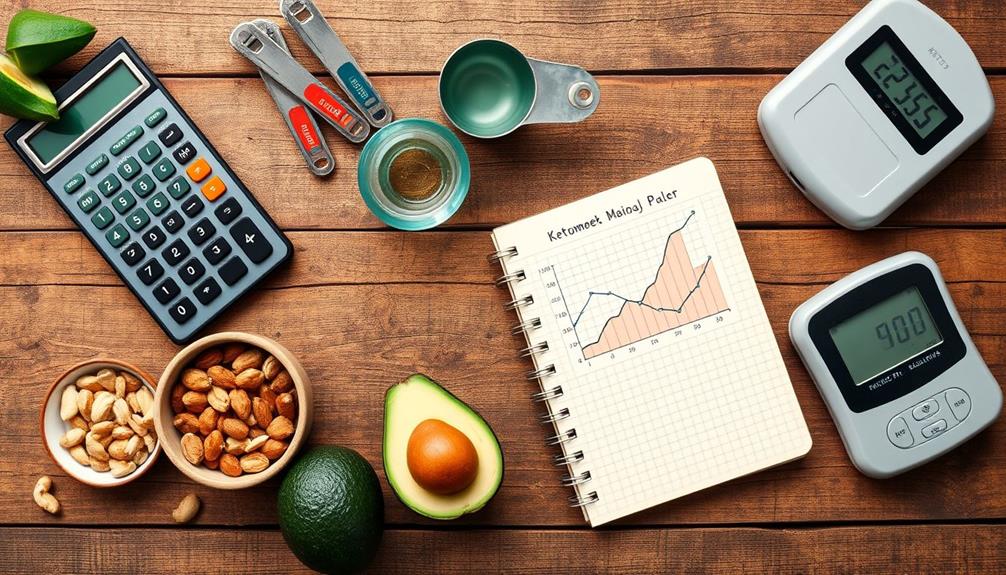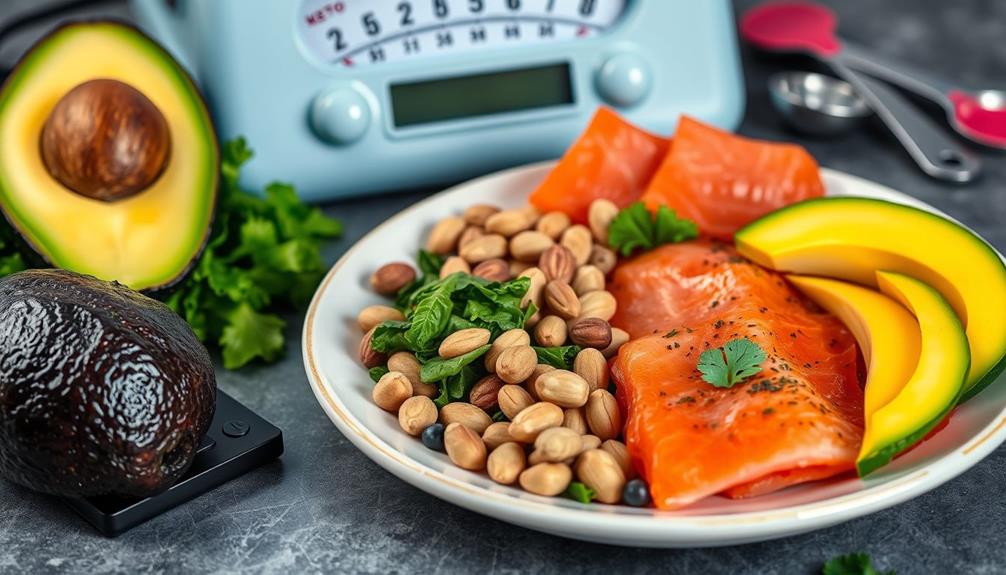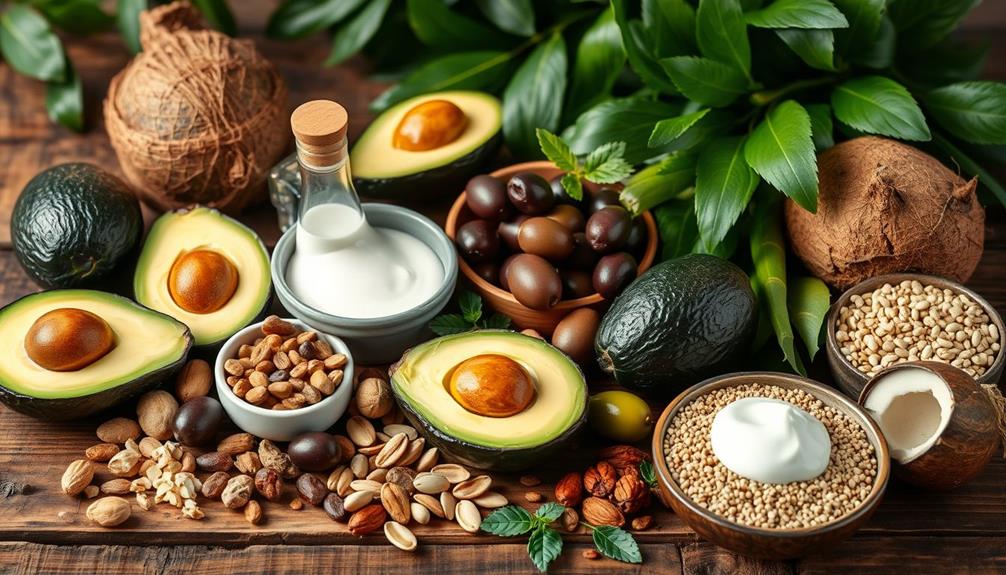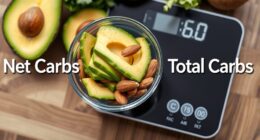To find your macros for the keto diet, start by calculating your Total Daily Energy Expenditure (TDEE) using the Mifflin-St Jeor equation. Aim for a macro ratio of about 70% fat, 25% protein, and 5% carbs. Limit your net carb intake to 20-50 grams per day to maintain ketosis. Determine your protein needs based on your activity level, typically between 0.6g and 1.2g per pound of lean body mass. Finally, use a macro calculator to help track your intake and adjust your ratios as necessary. There's much more to explore about optimizing your keto journey!
Key Takeaways
- Calculate your Total Daily Energy Expenditure (TDEE) to set effective macro goals for the keto diet.
- Aim for a macro ratio of 5% carbs, 25% protein, and 70% fat for optimal ketosis.
- Determine daily carb intake between 20-50 grams of net carbs to maintain ketosis.
- Adjust protein intake based on activity level, targeting 0.6g to 1.2g per pound of lean body mass.
- Utilize macro calculators to personalize your carb, protein, and fat needs for the keto diet.
Understanding Keto Macros

When you immerse yourself in the ketogenic diet, understanding your macros is vital for success. The keto diet typically follows a macro ratio of 5% carbs, 25% protein, and 70% fat. This unique distribution promotes ketosis, allowing your body to burn fat instead of sugars.
It's essential to calculate your daily calories to tailor your specific nutrient intake, whether your goal is weight loss, maintenance, or muscle gain. Incorporating high levels of antioxidants from foods like celery juice can enhance your overall health while on the diet.
To maintain a state of ketosis, you'll want to limit your daily carb intake to 20-50 grams of net carbs. This restriction helps keep your body in a fat-burning mode. Each macronutrient plays a significant role: carbs provide quick energy, protein supports muscle repair and growth, while fat serves as your primary fuel source on keto.
Understanding these roles can help you identify your ideal macros for the ketogenic diet, ensuring you meet your calorie intake effectively. By focusing on these components, you can create meals that align with your keto goals, making the journey smoother and more manageable.
Balancing your macros is the key to thriving on this diet and achieving your health objectives.
Setting Your Macro Goals

To set your macro goals for a keto diet, start by evaluating your daily calorie needs based on your weight objectives.
It's crucial to focus on incorporating physical activity to enhance results and support your macro goals.
Next, aim for a carb intake of 20-50 grams per day, while calculating your protein needs depending on your activity level.
Assessing Caloric Needs
Understanding your caloric needs is essential for setting effective macro goals on the keto diet. Start by determining your Total Daily Energy Expenditure (TDEE), which is calculated using your Basal Metabolic Rate (BMR) and your activity level.
You can find your BMR using the Mifflin-St Jeor equation, which takes into account your age, gender, height, and weight. Additionally, being aware of your financial health can help you allocate resources effectively towards your health goals, including dietary changes.
Aim for a caloric deficit of around 20-30% below your TDEE for weight loss, or consume calories equal to your TDEE for maintenance. Once you have your caloric target, you can assess your macro needs:
- Carb intake: Keep it between 20-50 grams per day to promote ketosis.
- Protein needs: Calculate this based on your activity level, aiming for 0.6g to 1.1g per pound of lean body mass.
- Fat intake: Allocate the remaining calories to fats, ensuring 70-80% of your total caloric intake comes from fats for ideal keto results.
Carb Intake Guidelines
Setting your carb intake is vital for achieving and maintaining ketosis on a ketogenic diet. Generally, you should limit your carb intake to 5% or less of your total daily calories, which translates to about 20-50 grams of net carbs per day. If you follow a 2,000-calorie diet, aim for a maximum of 20 grams of carbs. Those consuming 2,500-3,000 calories can have up to 35 grams to stay in ketosis.
Understanding content relevance and authority can also enhance your dietary approach, making sure you're informed about the best practices for your health goals.
To calculate net carbs, subtract fiber from total carbohydrates, giving you the effective carb intake that influences ketosis. Your individual carb limit may vary based on factors like age, activity level, and specific health goals. Personal experimentation is essential to finding the right balance that works for you.
Regularly testing your ketone levels can help you identify your personal carb limits and make certain you're adhering to the ketogenic diet effectively. By understanding these guidelines and adjusting your carb intake accordingly, you'll be well on your way to achieving and maintaining a successful ketogenic lifestyle.
Protein and Fat Ratios
Often, achieving the right protein and fat ratios is vital for your success on the keto diet. To set your macro goals, you'll want to focus on your protein intake, which should be between 0.6g to 1.2g per pound of lean body mass. If you're moderately active, aim for about 0.9g per pound.
Additionally, it's important to take into account how certain dietary choices can impact your overall health and well-being, such as the role of hydration and nutrient-rich foods in a gout-friendly diet. The typical keto macro ratio is around 70-80% fat, 20-25% protein, and 5% or less carbohydrates, essential for promoting ketosis and optimizing fat burning.
Here are some important points to keep in mind:
- A 2,000 calorie diet typically breaks down to 156-178 grams of fat, 100-150 grams of protein, and 20-25 grams of carbs.
- Calculate your fat needs by subtracting calories from protein and carbs from your total calorie goal, then convert the remaining calories into grams of fat.
- Adjust protein and fat ratios as needed based on your individual responses and progress; excessive protein can hinder ketone production.
Carb and Protein Requirements

When you're following a keto diet, understanding your carb and protein requirements is essential. Proper nutritional planning is vital for achieving your health goals, especially in regards to key domains of development that influence physical well-being.
You'll want to keep your net carbs around 20 grams per day to stay in ketosis, and how much protein you need will depend on your activity level.
Calculating net carbs is simple: just subtract the fiber from total carbs to get your net intake.
Daily Carb Intake Guidelines
Understanding your daily carb intake is essential for successfully following a ketogenic diet. To maintain ketosis, it's vital to limit your net carbs. If your caloric intake is 2,000 calories, aim for 20 grams or fewer of net carbs daily. For those consuming between 2,000-2,500 calories, you should target 25-30 grams, while individuals with a caloric intake of 2,500-3,000 calories can increase to 30-35 grams of carbs per day.
This careful management of carbs is important for emotional regulation, similar to how individuals with BPD manage their symptoms through structured treatment plans.
When calculating net carbs, remember to subtract fiber from total carbohydrates, as fiber doesn't greatly impact blood sugar levels.
Here are some guidelines to take into account:
- A moderate active individual weighing 150 pounds needs about 135 grams of protein per day.
- Adjust protein intake based on your activity level: 0.6g per pound for sedentary individuals and up to 1.1g for very active ones.
- Keep in mind that your body weight and activity level considerably influence both your protein and carb needs.
Protein Needs by Activity
Your protein needs depend greatly on your activity level, as different lifestyles demand varying amounts of this essential macronutrient.
If you're sedentary, aim for about 0.6g to 0.8g of protein per pound of lean body mass. For those who are moderately active, like someone who exercises a few times a week, you should target around 0.8g to 1.0g per pound. For example, a 150-pound moderately active person would need approximately 135 grams of protein daily.
Incorporating gold IRAs for stability into your financial strategy can provide peace of mind, allowing you to focus on your health goals without financial stress.
If you're very active, especially with weight lifting, your protein needs increase considerably. You might require 1.0g to 1.2g per pound of lean body mass to support muscle maintenance and growth.
Remember, protein contributes 4 calories per gram, so it's vital to factor this into your total caloric intake when determining macro ratios for the keto diet.
However, be cautious; excessive protein can hinder ketone production and slow down weight loss, which is particularly important for those on a strict ketogenic approach.
Balancing your protein needs with your activity level is key to achieving your health and fitness goals on the keto diet.
Net Carbs Calculation Method
Calculating net carbs is an essential step in maintaining a ketogenic diet, especially after determining your protein needs based on your activity level. Different foods and beverages can impact your overall macros, so understanding how to brew the perfect cup of coffee without adding excessive carbohydrates is advantageous.
To calculate net carbs, simply subtract fiber from total carbohydrates. Your target intake should generally be between 20-50 grams of net carbs per day to promote ketosis effectively.
Here are some key points to keep in mind:
- For a daily caloric intake of 2,000 calories, aim for 20 grams or less of carbs to support a ketogenic state.
- Understanding your protein needs is fundamental; depending on your activity level, you should target 0.6 to 1.2 grams of protein per pound of lean body mass.
- For example, if you weigh 150 pounds and are moderately active, aim for around 135 grams of protein daily to maintain muscle and overall health.
Properly managing your net carbs and protein intake is significant, as excessive protein can hinder ketone production and weight loss on a keto diet.
Balancing these macronutrients will help you stay on track with your macro ratio and achieve your dietary goals.
Calculating Fat Intake

When commencing a keto diet, determining your fat intake is vital for achieving your nutritional goals. Start by calculating your total daily calorie needs and subtracting the calories allocated for carbohydrates and protein. Each gram of fat provides approximately 9 calories, so divide the remaining caloric total by 9 to find the grams of fat you should consume daily.
Here's a quick reference table to help you understand the process:
| Category | Example Calculation |
|---|---|
| Total Daily Calories | 2,000 calories |
| Carbs (20g) | 80 calories (20g x 4) |
| Protein (150g) | 600 calories (150g x 4) |
| Remaining Calories | 1,120 calories (2,000 – 80 – 600) |
| Grams of Fat Needed | 124 grams (1,120 ÷ 9) |
Maintaining a higher fat intake is important for satisfying hunger and providing the necessary energy to promote ketosis, typically making up 70-80% of your calorie intake on a keto diet. Regularly track and adjust your fat intake to verify it aligns with your personal macro goals and supports your overall ketogenic diet success.
Tracking Your Macros

Maintaining the right balance of macronutrients is key to thriving on a keto diet, and tracking your macros plays a significant role in this process. To guarantee you're hitting the ideal ratios of 5% carbs, 25% protein, and 70% fat, using a keto-friendly app or macro calculator can be incredibly helpful.
These tools allow you to log your daily food intake and adjust as necessary to meet your goals. Additionally, exploring best websites to earn money online can provide you with resources to find ways to fund your keto-friendly food choices.
To track your macros effectively, consider these tips:
- Regularly calculate net carbs by subtracting fiber from total carbohydrates to maintain your daily limit of 20-50 grams for ketosis.
- Monitor your calorie intake to stay within your required range while maintaining the right balance of fat, protein, and carbs.
- Regularly assess your progress and adjust your macro ratios based on your weight loss or maintenance goals.
Consistent tracking not only aids in achieving nutritional ketosis but also enhances your understanding of food choices and portion sizes.
Adjusting Your Macro Ratios

Frequently adjusting your macro ratios is essential for optimizing your keto diet to align with your unique health goals and activity levels. The standard ketogenic ratio of 5% carbs, 25% protein, and 70% fat mightn't suit everyone.
If you have higher activity levels, consider increasing your protein intake to around 30% while reducing fat to 65%. This adjustment can support muscle maintenance and recovery.
When calculating your macros, take into account your total daily caloric intake. Apply your desired macro percentages to determine the grams of each macronutrient you need. A keto macro calculator can be a valuable tool in this process, helping you visualize how changes in one macronutrient affect the others and your overall caloric intake.
Regularly track your food intake to see how your adjustments impact your weight loss, energy levels, and overall health. If you're not seeing the desired results, don't hesitate to further adjust your macro ratios.
Creating a calorie deficit is vital for fat loss, so fine-tuning your carb intake, protein intake, and fat levels is key to achieving your goals on the keto diet.
Utilizing Macro Calculators

To optimize your keto diet effectively, utilizing a macro calculator can be a game changer. This tool helps determine your specific carb intake, protein, and fat needs by analyzing personal data like age, gender, weight, height, and activity level.
It uses the Mifflin-St. Jeor equation to calculate your Basal Metabolic Rate (BMR), which is essential for evaluating your Total Daily Energy Expenditure (TDEE).
Here are a few benefits of using a macro calculator:
- Structured Starting Point: It provides a personalized framework for your meal planning.
- Targeted Carb Intake: For ketosis, it typically recommends limiting net carbs to 20-50 grams per day.
- Adjustments Based on Progress: As you enter your weight goals—whether loss, gain, or maintenance—the calculator fine-tunes your protein and fat ratios, often suggesting 20-30% protein and 70-80% fat.
Frequently Asked Questions
How Do I Figure Out My Macros for Keto?
To figure out your macros, start by calculating your daily calorie needs. Then, set carb limits, determine your protein based on activity, and allocate fat to fill the remaining calories for a balanced intake.
How Do I Figure Out My Macros?
Figuring out your macros is like crafting a recipe for success. You assess your goals, calculate your calorie needs, and distribute your macronutrients wisely. It's a balancing act that fuels your journey towards health.
How Do I Find My Fat Macros on Keto?
To find your fat macros on keto, calculate your total daily calorie needs, subtract the calories from carbs and protein, then divide the remaining calories by 9 to determine your fat intake. Balance is key!
What Macros Should I Eat for Low Carb Weight Loss?
For low-carb weight loss, you should aim for about 70% fat, 25% protein, and 5% carbs. Track your intake closely to maintain this ratio and guarantee you stay within your daily calorie goals.
Conclusion
In your keto quest, mastering macros makes a monumental difference. By diligently determining your daily intake and adjusting as needed, you'll discover delightful results. Embrace the empowering experience of tracking, tweaking, and transforming your diet. With each step, you'll fuel your fat-burning fire and foster fantastic health. So, stay committed, celebrate small successes, and savor every savory bite on your journey to keto success. You've got this, and the rewards will be worth the effort!









